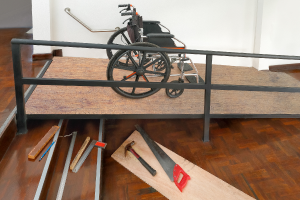Aluminum vs Wooden Wheelchair Ramps: A Comparison
When you need more accessible access to your home—whether you’re using a wheelchair, walker, or mobility scooter—a wheelchair ramp is a reliable option. But there are numerous options to choose from when installing wheelchair ramps in New Orleans, including various material choices. Two of the most popular material options available are aluminum and wood. Before you decide what material you want to use, it’s important to compare these two options. Keep reading to get an in-depth comparison, and to find out which option is the clear winner.

Appearance
Installation
Installing a wood ramp is much more complicated than installing an aluminum ramp. While professionals should do both, an aluminum ramp can take anywhere from 30 minutes to a few hours to install, while a wooden ramp can take several days, depending on its length. Due to the extra labor, a wood ramp will also typically cost you quite a bit more than an aluminum one, which is usually prefabricated and assembled on-site.
Permanence
While both options are incredibly sturdy, wooden ramps are much more permanent than aluminum ones. This is because wooden ramps need concrete anchors to hold them in place more often than not. This makes it extremely difficult ever to take the ramp down, which can be a problem if you ever intend to resell your home. On the other hand, aluminum ramps can easily be broken down and removed from the property if you sell, or if you otherwise no longer need the ramp in that position.
Maintenance
Aluminum ramps are incredibly easy to maintain. They stand up well to wear and tear, resist rusting and other forms of corrosion, and don’t ever need to be refinished. Sweep them off or hose them down as needed, and your aluminum wheelchair ramp will give you no troubles.
Wooden ramps, on the other hand, require much more effort. You’ll typically want to pressure wash them every few months, and you will probably need to repaint or refinish the surface each year to prevent rotting and warping.
Safety
Both wooden and aluminum wheelchair ramps are designed for safe and easy accessibility to your home. However, wooden surfaces can become slippery when wet, making them a potential hazard during rainy weather. Of course, most wood wheelchair ramps have textured, non-slip treads added to the planks to offset this. Unfortunately, this doesn’t prevent water from pooling on the surfaces, which can still present a hazard.
Aluminum wheelchair ramps usually have a surface that is both texture and perforated. This encourages water to drain off the surface while providing a non-slip surface for shoes and wheels alike. For this reason, aluminum wheelchair ramps tend to be just a bit safer than wooden ones.
While you may find yourself drawn to the natural beauty of a wooden ramp, it’s important to consider all of the factors involved when selecting a wheelchair ramp. Due to their durability, affordability, safety, and ease of maintenance, aluminum wheelchair ramps stand out as the clear winner in this side-by-side comparison. If you’re looking for wheelchair ramps for stairs in New Orleans, LA, contact K N Enterprise, LLC, today.









